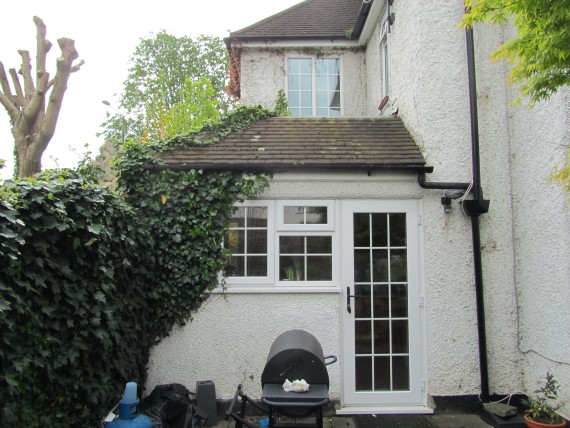The Contents of the Skip
While the renovation to make our house age-friendly is underway we are renting a flat close by, and go over regularly to check on progress.
Entering the back garden the first thing you see is the skip. As we peer inside, the contents give a clue to what has been going on in the house, and reminds us that there is no going back. The underlying structure of the house is revealed, the crumbling bitumen and horsehair fabric that was under the roof tiles, cavity walls that had never been insulated, soot covered bricks from the chimney lining, shallow parquet blocks laid directly onto concrete.
Building materials and technology exist now that the first owners of our house could not have imagined 70 years ago. For example, options for insulation are much greater; when we first investigated the loft we found the water pipes lagged with rolled up copies of Woman’s Weekly from 1956 and 1957, each lovingly tied on with string. While the magazine is still published, and we have inherited some of our parents’ thrift, we have not been stockpiling copies for future use.
The Romans had underfloor heating but the good news is that this no longer involves a servant stoking a fire under your house. The old central heating radiators did not appear in the skip due to their scrap value, but they were removed and we were not sorry to see them go. Having keenly observed the daily challenges for ageing relatives we know that effective and consistent space heating is part of staying independent at home.
The central heating system in our rented flat is not untypical of those in many homes. On the day we moved in I decided to check how the timer had been set. I opened the cupboard, which is mainly occupied by a hot water tank. I spotted the timer and realised I would need a torch. Torch in hand and neck contorted I looked for the operating instructions, expecting at least a set in microscopic print stuck to the fold down flap on the timer, but the flap had gone! No doubt a previous tenant had torn if off to read the instructions in daylight or through sheer frustration.
After a lengthy search on line, comparing illustrations and using some guesswork, I found what I believed were the instructions. Back to the cupboard, torch in hand and pressing various buttons as described, and after 20 minutes apparent success. However later that day I realised my labour was to no avail, the boiler comes on at times that I did not set, the red ‘on’ lights blink at me from the gloom in random fashion and the radiators disregard the single thermostat on the wall. The options now are to have heating on all day or use the one hour ‘top up’ when it gets chilly, which is what we do.
So how will underfloor heating make a difference?
As a child I recall my Mum warming our socks and vests on frosty mornings by turning on the oven and hanging clothes in front of the open door. While this image brings a brief nostalgic glow, it reminds me how sporadic the heating was then, in Winter we moved between hot and cold more often than a group of Finns at a sauna party.
Things we are looking forward to in the new home:
- Only needing thermal underwear when outdoors in Winter. While we don’t want to waste fuel we want daily tasks to be manageable and not struggle with layers of garments. (When I helped my Mum get undressed one day last Winter it was akin to Salome and her seven veils, but without the dancing)
- Thermostats and timers in locations where we can read and operate them (not in dark cupboards or on the kitchen wall at arm’s reach across a working surface.)
- Balancing the heating in different areas of the house using thermostats (not going round the house with the tiny key that you can never find, to release air from the radiators, shouting down to your partner to top up the water in the system and adjusting radiator valves endlessly.)
The outside of the house is covered with crumbling and bubbling pebbledash that has been ravaged by the rain, sun and vigorous climbing plants. Here is a photo of the old kitchen extension when we moved in, with ivy rapidly engulfing windows and roof.
Given the lack of cavity wall insulation we decided on a combined solution. We chose an external insulation material that will cover the pebbledash (after removing loose material and making good) and provide a smooth render finish. It should be long lasting and reduce heat loss in Winter and heat gain in Summer. We have two challenging tasks to complete:
- Decide on the render colour – bearing in mind that our neighbours and every passer-by will see it as much or more often than us.
- Making sure the Virginia Creeper that used to festoon the front of the house, grow in through windows (curtains left by the previous owner bore the distinctive sucker marks from the wayward plant) and blocked gutters and drains, is well a truly dead.
This is Margaret’s fourth guest Housing LIN blog following the progress of turning her 1950s house into an accessible home. The other parts are:
- Part 1 - You are too young to be thinking about this
- Part 2 - What are you having done?
- Part 3 - Will it add value to your home?


Comments
Add your comment